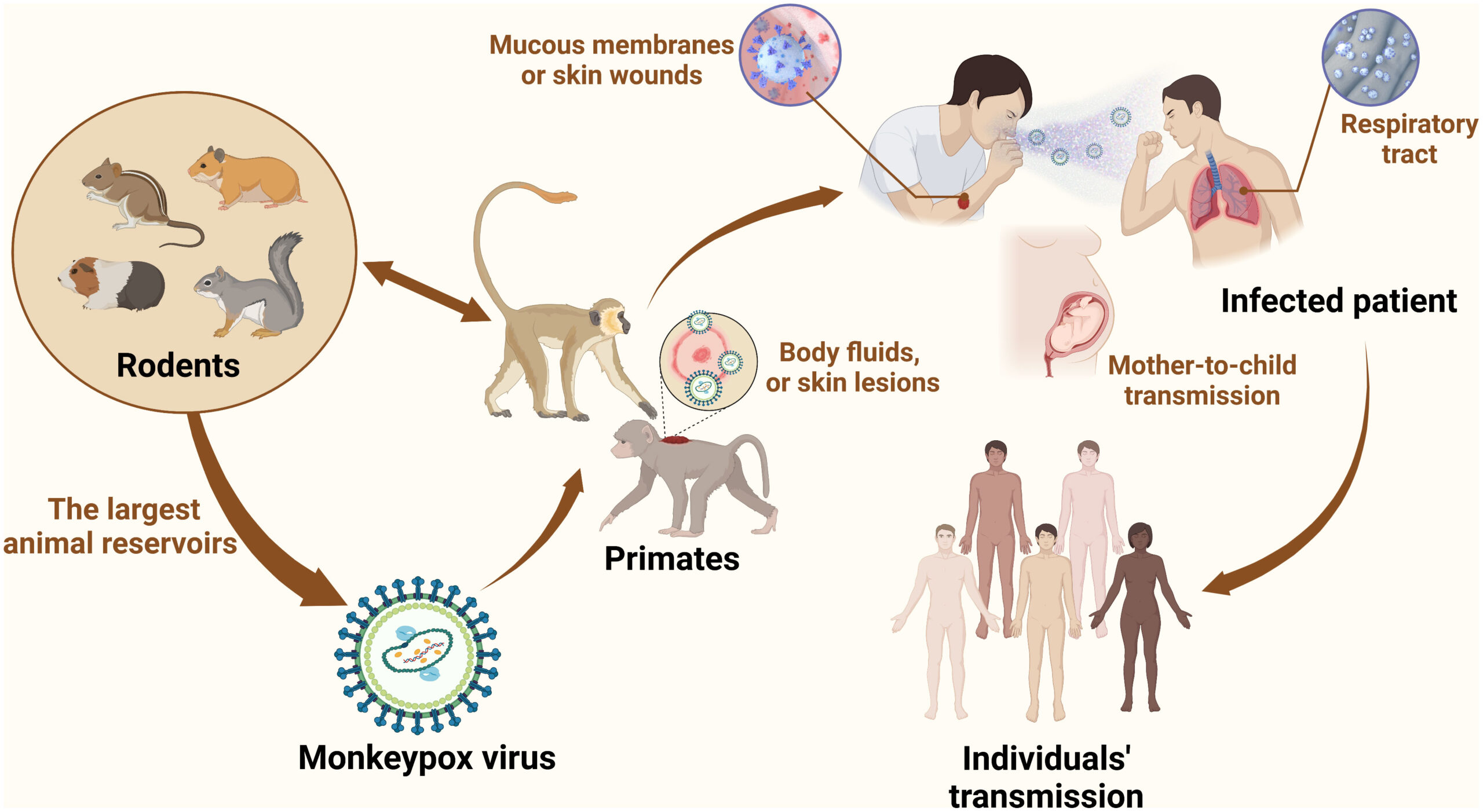COMPREHENSIVE OVERVIEW OF MONKEYPOX: ORIGIN, TRANSMISSION, SYMPTOMS, AND PUBLIC HEALTH RESPONSE
Source : Frontiers
Origin and History:
- Geographical Origin: Monkey pox is a viral zoonosis (a virus transmitted to humans from animals) with symptoms similar to those seen in smallpox patients, although it is clinically less severe. It was first discovered in 1958 in colonies of monkeys kept for research, hence the name “monkey pox.” The first human case was recorded in 1970 in the Democratic Republic of Congo.
- Spread: Monkey pox is primarily found in Central and West African countries, often in tropical rainforest areas, but cases have been reported outside Africa due to international travel.
Transmission:
- Animal to Human: The virus can spread to humans from animals through direct contact with blood, bodily fluids, or cutaneous or mucosal lesions of infected animals. Eating inadequately cooked meat and other animal products of infected animals is also a risk factor.
- Human to Human: Human-to-human transmission can occur through respiratory droplets, contact with infected bodily fluids, and contaminated materials like bedding.
Symptoms:
- Incubation Period: Typically 6 to 13 days, but can range from 5 to 21 days.
- Symptoms: Monkey pox symptoms are similar to those of smallpox but are usually milder. It begins with fever, headache, muscle aches, back pain, swollen lymph nodes, chills, and exhaustion. Within 1 to 3 days (sometimes longer) after the fever, a rash develops, often starting on the face and then spreading to other parts of the body.
Diagnosis:
- Laboratory Testing: Diagnosis of monkey pox relies on the detection of the virus’ DNA by polymerase chain reaction (PCR) testing. Samples are ideally taken from skin lesions, the roof or fluid from vesicles and pustules, and dry crusts.
- Differential Diagnosis: Monkey pox must be differentiated from other illnesses that cause rash, such as chickenpox, measles, bacterial skin infections, scabies, syphilis, and medication-associated allergies.
Treatment:
- Symptomatic Treatment: There is no specific treatment approved for monkey pox. Treatment is generally supportive, with care focused on relieving symptoms, managing complications, and preventing long-term sequelae.
- Antivirals: Tecovirimat (TPOXX), an antiviral drug approved for smallpox, has shown effectiveness against monkey pox and has been used under investigational protocols in some outbreaks.
- Vaccination: The smallpox vaccine has been shown to provide protection against monkey pox. The newer generation of smallpox vaccines, such as the JYNNEOS vaccine (also known as Imvamune or Imvanex), is approved for the prevention of monkey pox in some countries. Post-exposure vaccination within 4 days of exposure can prevent the onset of the disease or reduce the severity of the symptoms.
Difficulty in Cure:
- Challenges: While the disease is usually self-limiting, complications can occur, especially in children, pregnant women, and immune compromised individuals. Severe cases are rare but can result in death, particularly among children. The case fatality rate has historically ranged from 1% to 10% depending on the strain.
- Control Measures: Managing outbreaks requires isolation of patients, contact tracing, and vaccination of close contacts to control the spread. Public awareness and education about the modes of transmission are also crucial to reduce human-to-human transmission.
Current Situation and Public Health Response:
- Outbreaks: Recently, monkey pox has gained global attention due to outbreaks in countries where the virus is not typically endemic. These outbreaks have led to increased surveillance, research, and efforts to manage and prevent the spread.
- Global Coordination: The World Health Organization (WHO) and national health bodies have been working together to monitor and respond to monkey pox outbreaks, providing guidelines for diagnosis, treatment, and prevention.
Prevention:
Avoiding Contact:
- By avoiding close contact with infected individuals and practicing good hand hygiene, you can reduce the risk of human-to-human transmission.
- Animal Precautions: Reducing the risk of zoonotic transmission by avoiding contact with animals that could harbor the virus, and cooking all animal products thoroughly before consumption.
- In summary, while monkey pox is generally less severe than smallpox and often self-limiting, it can be serious in certain populations, and prompt medical attention is important. Public health measures, including vaccination and awareness, are key to controlling outbreaks.
Source : Indian Express
Mains Questions
- Discuss the global implications of zoonotic diseases with reference to recent outbreaks such as monkey pox.
- General Studies Paper II (Governance, Constitution, Polity, Social Justice and International Relations)
- How does the emergence of diseases like monkey pox highlight the need for stronger global health surveillance systems? Discuss the challenges and measures required for effective disease monitoring. (GS III)




